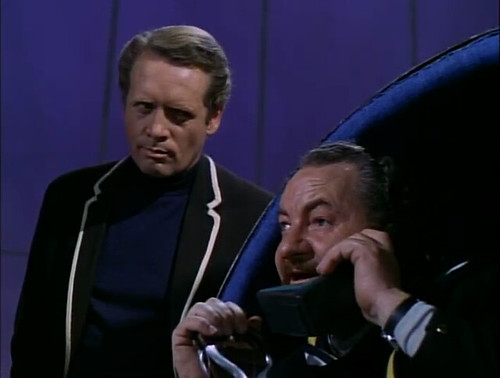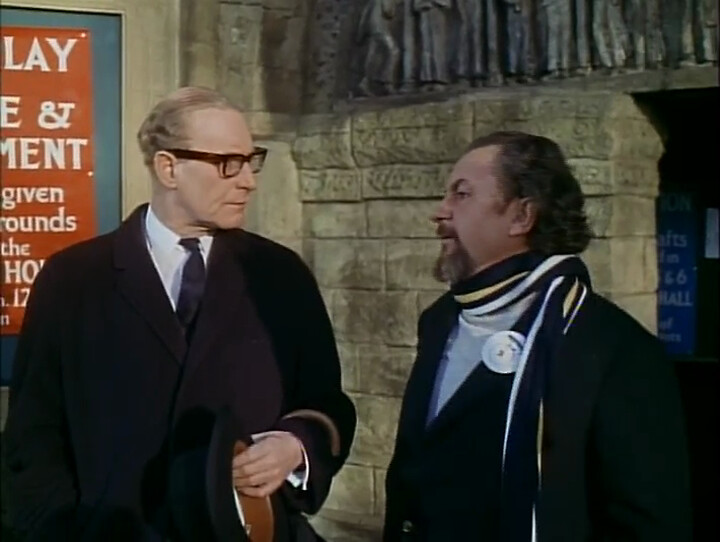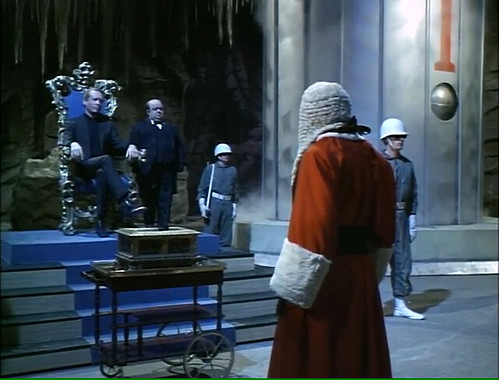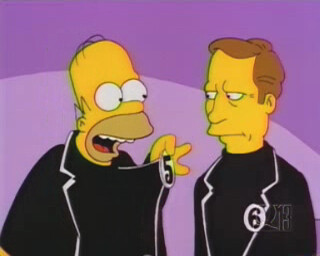Fifty years later, writer/director Patrick McGoohan’s spy-fi show The Prisoner remains as entertaining and bewildering as when it premiered. It’s only 17 episodes long, and possibly the strangest show in TV history (non-anime division). Superficially, The Prisoner is the story of a spy rebelling against his captors. However, it’s filtered through the pop-art stylings of the 1960s and utterly unique.
McGoohan became famous as spy John Drake on Danger Man (Secret Agent in the US). Drake was a proto-Le Carré character, more realistic than Bond (a role McGoohan was offered), with his superiors more interested in the status quo than saving the world. The cynicism that informed Drake carried over to The Prisoner, and he infused that paranoia and conspiracy with psychedelia.
In the beginning, McGoohan’s character angrily resigns and attempts to leave the country, only to be drugged and kidnapped. When he awakens, he’s in the Village, a pleasant seaside town always with mild, warm weather and a slight chance of rain. No location is given, and no one ever travels outside it (the Village itself is Portmeirion, North Wales). We see all this in the jazzy opening credits:
Upon arrival, McGoohan is summoned to meet Number Two, who’s apparently in charge of the Village. Number Two explains that all they want is to know why McGoohan resigned. McGoohan simply replies, “A matter of conscience.”
This initial encounter sets up the driving conflict of the show: individuality versus conformity. McGoohan’s spy refused to work with the system (fans argue this spy is actually John Drake, who became fed up with the moral compromises). Number Two wants to know the reason, but presumably it’s in the letter from the opening credits. So why ask? They want McGoohan to confess, to conform, to give up what makes him him. And he won’t. He yells out, “I will not make any deals with you. I’ve resigned. I will not be pushed, filed, stamped, indexed, briefed, debriefed, or numbered! My life is my own!”
When McGoohan confronts Number Two later that episode, he finds a completely different person wearing the badge. Here we learn Number Two isn’t a person, but a title. Nearly every episode will have a different Number Two, each trying different tactics to make McGoohan confess. Instead of asserting any individual identity, Two is a willing cog in the machine enforcing order and conformity. He tells McGoohan everyone has a number, and he is actually Number Six. Six also learned of Two’s boss… Number One. But he/she/it is remote and unknown to anyone except Two.
The fan favorite Number Two is Leo McKern from the episode “The Chimes of Big Ben.” Most Twos have similar personalities: aloof, haughty, with a dry sense of humor, and always holding Six in contempt. McKern’s Two isn’t like that. He’s fascinated by Six and loves sparring with him. He’s an outsized man with a hearty laugh, which contrasts well with the dour and defiant Six. Whereas most Twos express the power and control of The Village, McKern’s Two seems to believe in it. He’s the ultimate overseer and member of the Village:

Two: I am definitely an optimist. That’s why it doesn’t matter who Number One is. It doesn’t matter which “side” runs the Village…Both sides are becoming identical. What in fact has been created is an international community — perfect blueprint for world order. When the sides facing each other suddenly realize that they’re looking into a mirror, they will see that this is the pattern for the future.
Six: “The whole Earth as The Village?”
Two: “That is my hope.”
One of the most contentious discussions regarding the show is actually episode order. Everyone involved agrees that the first episode should be first, and the last two episodes should be last. Other than that, there is no official, canonical order of the episodes. You can, in theory, watch them in any order you want. Fans of the show have created unofficial orders by tracking references within the episodes and following the escalation of Six and the Village/Twos’ opposition. The best-known fan ordering is by the “Six of One Society”, the semi-official Prisoner fanclub. Their order is used by A&E, who has the TV and DVD licenses, so that’s the order you’re likeliest to encounter (and I follow it here).
Six’s initial goal is to escape the Village, but the Twos continue to defeat him. The rules for how the Village works are never explained, so anything and everything could be used against Six. He knows just as little as we do. The Village is arbitrary by design, because if it can be predicted, then it can be understood and potentially defeated. If it operates by whim, the only survival is to conform.
One escape attempt (“Dance of the Dead”) has him arrested for breaking the rules and found guilty by a jury of Nero, Elizabeth I, and Napoleon. Another has Six running for the office of Number Two (“Free For All”), but when he wins, the election is revealed as a sham power struggle. In “Checkmate,” Six thinks he can identity the plainclothes guards by their arrogance, but he’s accused of being a potential guard by a fellow prisoner because Six is the most arrogant one of all!
The episode “The Chimes of Big Ben” marks a turning point in Six’s goals. He successfully escapes and finds his way back to London, debriefing his superiors about the existence of the Village. However, when he hears the titular chimes, he notices the time is wrong. He opens the door to leave their office and walks right back into the Village.
This episode introduces two huge shifts – first, Six’s superiors are somehow in league with the Village. They even ask Two for further orders, implying Two outranks them. The Village is revealed as having power on a global scale, echoing Two’s earlier monologue about “the whole Earth as the Village.” By contrast, Six no longer wants to merely escape. He tells Two his plan now is, “Escape, come back, wipe this place off the face of the Earth, obliterate it and you with it.” Six’s slow entrapment is evident by his plan. He initially tried to flee the Village. Then his goal was to return to British intelligence and reveal the Village. By the end of the episode, we know escape is impossible because British intelligence is part of it. The only way out is to destroy it.

In the next set of episodes, Six takes the offensive and the Twos escalate accordingly. Six finds ways of striking back at the Twos, often using the same methods they used to try to coerce him. In “A, B, and C”, Two drugs Six and monitors his dreams for clues – Six learns of the trick and manipulates his own dreams to implicate Two. In “The General”, Two uses a supercomputer to try to indoctrinate the Villagers; Six destroys it with an existential logic bomb, asking it “why?” When another Two attempts to brand Six as an “unmutual” using hypnosis (“A Change of Mind”), Six instead hypnotizes another prisoner to accuse Two of being unmutual, chasing Two out the Village. Six exacts revenge on a sadistic Two by driving him paranoid and insane (“Hammer into Anvil”).
“The Girl Who Was Death” is where McGoohan begins leaning fully into the surrealism of his world. A general is assassinated with an exploding cricket ball, so Six investigates it and learns the general was hunting a doomsday rocket. Six finds the rocket, its designer, and his henchmen (dressed as Napoleon and his army), and tricks them into being blown up by their own rocket. Then the entire episode is revealed as a bedtime story Six tells the children in the Village, with Two hoping Six would drop his guard and reveal why he resigned. Yet that weirdness only hints at the last two episodes.
The penultimate episode, “Once Upon a Time” features the return of McKern as Two. To uncover why Six resigned and what makes him so iron-willed, Two will regress Six to his childhood and through Shakespeare’s seven ages of man. It’s an extreme measure that will break either the interrogator or the victim, but Six is a threat to the entire Village system. If destroying him is the cost of revealing how he subverted or evaded the system, so be it. His individual will must not be allowed to ruin what the Village has accomplished.
Six defeats Two, causing Two’s death, and the Village supervisor asks what he wants. Six only replies, “Number One,” and the supervisor leads Six away.
“Fall Out” is the king of inscrutable finales. Six is led to an underground chamber with masked men assembled before him, and a camera labeled “1” watching him. He is given a throne and told he passed the “ultimate test” and won the “right to be individual.” Two’s body is wheeled in and brought back to life as an undesirable rebel, as well as 48, a young, hip member of the Village, who sings “Dem Bones” to disrupt the proceedings.

Six will be allowed to return home after giving a speech instructing the assembled men on how to be individuals, but every time he says “I”, he’s drowned out by their chanting. When led to see Number One, he finds a hooded man. Removing the hood reveals a gorilla mask. Removing that, he briefly sees the face of Number One: himself.
Six, Two, 48, and the Village butler then detonate a nuclear missile housed in the Village and escape in a firefight set to the Beatles’ “All You Need is Love”. They shortly arrive in London, where 48 hitches a ride, Two walks to the Houses of Parliament, and the butler leads Six back home. Six hops in his Lotus 7 and rides off, exactly as the show opens.
So what does this all mean? McGoohan rarely spoke about it, though there are jabs at the media and critics in the show, anticipating their reactions to it. Six enters an art competition in “The Chimes of Big Ben”, and all he says to the judges about his piece is that, “It means what it is.” Presumably this is what McGoohan thinks about The Prisoner.
The most obvious theme is individualism versus conformity, but it’s not treated simplistically. Six has an iron will, but that very trait leads to his downfall in “Checkmate” – his individuality becomes a liability. His sense of justice prevents a Two from being assassinated in “It’s Your Funeral,” even though the murder would have helped destabilize the Village. He learns to manipulate the Villagers for his own uses. And his refusal to compromise in any way destroys the Village, and while that seems ideal, is detonating a nuclear missile worth it? To what extent is individuality worth defending if it means destroying everything in its path to preserve it?
Though McGoohan sympathized with Six, making Six also Number One showed his skepticism towards his individuality: “Number One was depicted as an evil, governing force in this Village. So, who is this Number One? We just see the Number Twos, the sidekicks. Now this overriding, evil force is at its most powerful within ourselves and we have constantly to fight it, I think, and that is why I made Number One an image of Number Six. His other half, his alter ego.”
If Six is the Rebel, One is the Tyrant, the other ultimate individual. Instead of seeking to maximize and share freedom with others, the tyrant hoards his own individual freedom at the expense and enslavement of others. Six himself sometimes blurred the line — in “A Change of Mind”, he used the same hypnosis and public accusations to oust Two that Two was trying to use against him, using the other Villagers as means to an end.
The Prisoner is a paradoxical show, in that its themes are stated upfront while it’s obscure on what it all means. If the ending is the chance for the artists to leave us with one last conceit, what does McGoohan mean by blowing everything up, then putting us right back where we started? His resistance to elaborate on much of the show at all has inspired continuations, and parodies (including a guest appearance on The Simpsons and a comic by Jack Kirby himself), and remakes.

We’re used to puzzles in our shows now – Who killed Laura Palmer? What is the Island? Who’s working with the Greys? But fifty years later, we’re no closer to solving what exactly the Village is, or how its Villagers are chosen, or who runs it, or… anything, really. And perhaps that’s the point. It operates as part myth, part allegory, part dream. Few shows have attempted as risky a high-wire act, and it’s debatable if this one even pulled it off. But its messy failures are so unique and aggressively bizarre that it earned the reputation of cult classic. Just like Six, McGoohan’s refusal to compromise gave us one of the most singular and intriguing television shows of all time, and also like Six, he refuses to give us information, withholding any concrete meaning from us. The only way to understand it is to begin again, right where it started. Be seeing you.

